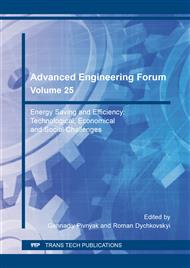[1]
Lozynskyi, V. H., Dychkovskyi, R. O., Falshtynskyi, V. S., & Saik P. B., (2015). Revisiting possibility to cross disjunctive geological faults by underground gasifier. Naukovyi Visnyk Natsionalnoho Hirnychoho Universytetu, No. 4, p.22–28.
DOI: 10.29202/nvngu/2018-3/5
Google Scholar
[2]
Bondarenko, V., Lozynskyi, V., Sai, K., & Anikushyna, K. (2015).
Google Scholar
[3]
Bondarenko, V., Tabachenko, M. and Wachowicz, J., 2010. Possibility of production complex of sufficient gasses in Ukraine. New Techniques and Technologies in Mining. CRC Press/Balkema, The Netherlands, 113-119.
DOI: 10.1201/b11329-19
Google Scholar
[4]
Dychkovskyi, R., Falshtynskyi, V., Lozynskyi, V., & Saik, P. (2015). Development the concept of borehole underground coal gasification technology in Ukraine. New Developments in Mining Engineering 2015, 91-95. https: /doi. org/10. 1201/b19901-18.
DOI: 10.1201/b19901-18
Google Scholar
[5]
Ovchynnikov, M., Ganushevych, K., & Sai, K. (2013). Methodology of gas hydrates formation from gaseous mixtures of various compositions. Mining of Mineral Deposits, 203-205. https: /doi. org/10. 1201/b16354-37.
DOI: 10.1201/b16354-36
Google Scholar
[6]
Oliver, R. L., & Youngberg, A. D. (1984). Geology of the Hanna Formation, Hanna Underground Coal Gasification Site, Hanna, Wyoming. https: /doi. org/10. 2172/5237516.
DOI: 10.2172/5237516
Google Scholar
[7]
Sadovenko, I., Inkin, O., & Zagrytsenko, A. (2016).
Google Scholar
[8]
Bielowicz, B., & Kasiński, J. R. (2014). The possibility of underground gasification of lignite from Polish deposits. International Journal of Coal Geology, 131, 304-318. https: /doi. org/10. 1016/j. coal. 2014. 06. 025.
DOI: 10.1016/j.coal.2014.06.025
Google Scholar
[9]
Falshtynskyi, V., Lozynskyi, V., Saik, P., Dychkovskyi, R., & Tabachenko, M. (2016).
Google Scholar
[10]
Falshtynskyi, V., Dychkovskyi, R., Lozynskyi, V., & Saik, P. (2015).
Google Scholar
[11]
Bondarenko, V., Dychkovskiy, R., & Falshtynskiy, V. (2009). Synthetic Stowing of Rockmass at Borehole Underground Coal Gasification (BUCG). Deep Mining Challenges, 169-177. https: /doi. org/10. 1201/noe0415804288. ch18.
DOI: 10.1201/noe0415804288.ch18
Google Scholar
[12]
Kuzmenko, O., Petlyovanyy, M., & Heylo, A. (2014). Application of fine-grained binding materials in technology of hardening backfill construction. Progressive Technologies of Coal, Coalbed Methane, and Ores Mining, 465-469.
DOI: 10.1201/b17547-79
Google Scholar
[13]
Kochura, I. V. (2012). Coal Market of Ukraine: Analysis and Development Background / GeoScience Engineering, 58(1). https: /doi. org/10. 2478/gse-2014-0034.
Google Scholar
[14]
Dychkovskyi, R.O. (2010). Mechanized coal seams extraction in faulting zones of rock massif in Lvivsko-Volynskyi coal basin conditions. Dnipropetrovsk: National Mining University, 110 p.
Google Scholar
[15]
Struev, M.I., Isakov, V.I., & Shpakova, V.B. (2014).
Google Scholar
[16]
Olateju, B., & Kumar, A. (2013).
Google Scholar
[17]
Khadse, A. N. (2015). Resources and economic analyses of underground coal gasification in India. Fuel, 142, 121–128. https: /doi. org/10. 1016/j. fuel. 2014. 10. 057.
DOI: 10.1016/j.fuel.2014.10.057
Google Scholar
[18]
Grainger, L., & Gibson, J. (1981). Economics of Underground Coal Gasification. Coal Utilisation, 388-397. https: /doi. org/10. 1007/978-94-011-7352-0_18.
DOI: 10.1007/978-94-011-7352-0_18
Google Scholar
[19]
Falsztinskij, W., Diczkowskij, E., & Łozinskij, W. (2010).
Google Scholar
[20]
Bell, D. A., Towler, B. F., & Fan, M. (2011). Underground Coal Gasification. Coal Gasification and Its Applications, 101-111. https: /doi. org/10. 1016/b978-0-8155-2049-8. 10005-1.
DOI: 10.1016/b978-0-8155-2049-8.10005-1
Google Scholar
[21]
Grainger, L., & Gibson, J. (1981). Economics of Underground Coal Gasification. Coal Utilisation, 388-397. https: /doi. org/10. 1007/978-94-011-7352-0_18.
DOI: 10.1007/978-94-011-7352-0_18
Google Scholar
[22]
Tabachenko, M., Saik, P., Lozynskyi, V., Falshtynskyi, V., & Dychkovskyi R. (2016).
Google Scholar
[23]
Dubiński, J., & Turek, M. (2015). Basic Aspects Of Productivity Of Underground Coal Gasification Process. Archives of Mining Sciences, 60(2). https: /doi. org/10. 1515/amsc-2015-0029.
DOI: 10.1515/amsc-2015-0029
Google Scholar
[24]
Aghalayam, P. (2010). Underground Coal Gasification: A Clean Coal Technology. Handbook of Combustion. https: /doi. org/10. 1002/9783527628148. hoc082.
DOI: 10.1002/9783527628148.hoc082
Google Scholar
[25]
Mochernyi, S.V. (2000). Economic Encyclopedia. Кyiv: Akademia, 864.
Google Scholar
[26]
Zhamoida, O. (2016). Managing mining enterprises' assets as the basis of their competitiveness. Mining of Mineral Deposits, 10(4), 50-55. https: /doi. org/10. 15407/mining10. 04. 050.
DOI: 10.15407/mining10.04.050
Google Scholar


